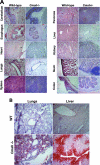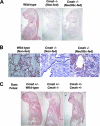N-glycolylneuraminic acid deficiency in mice: implications for human biology and evolution
- PMID: 17420276
- PMCID: PMC1900035
- DOI: 10.1128/MCB.00379-07
N-glycolylneuraminic acid deficiency in mice: implications for human biology and evolution
Abstract
Humans and chimpanzees share >99% identity in most proteins. One rare difference is a human-specific inactivating deletion in the CMAH gene, which determines biosynthesis of the sialic acid N-glycolylneuraminic acid (Neu5Gc). Since Neu5Gc is prominent on most chimpanzee cell surfaces, this mutation could have affected multiple systems. However, Neu5Gc is found in human cancers and fetuses and in trace amounts in normal human tissues, suggesting an alternate biosynthetic pathway. We inactivated the mouse Cmah gene and studied the in vivo consequences. There was no evidence for an alternate pathway in normal, fetal, or malignant tissue. Rather, null fetuses accumulated Neu5Gc from heterozygous mothers and dietary Neu5Gc was incorporated into oncogene-induced tumors. As with humans, there were accumulation of the precursor N-acetylneuraminic acid and increases in sialic acid O acetylation. Null mice showed other abnormalities reminiscent of the human condition. Adult mice showed a diminished acoustic startle response and required higher acoustic stimuli to increase responses above the baseline level. In this regard, histological abnormalities of the inner ear occurred in older mice, which had impaired hearing. Adult animals also showed delayed skin wound healing. Loss of Neu5Gc in hominid ancestors approximately 2 to 3 million years ago likely had immediate and long-term consequences for human biology.
Figures






References
-
- Altheide, T. K., T. Hayakawa, T. S. Mikkelsen, S. Diaz, N. Varki, and A. Varki. 2006. System-wide genomic and biochemical comparisons of sialic acid biology among primates and rodents: evidence for two modes of rapid evolution. J. Biol. Chem. 281:25689-25702. - PubMed
-
- Angata, T., and A. Varki. 2002. Chemical diversity in the sialic acids and related alpha-keto acids: an evolutionary perspective. Chem. Rev. 102:439-470. - PubMed
-
- Bardor, M., D. H. Nguyen, S. Diaz, and A. Varki. 2005. Mechanism of uptake and incorporation of the non-human sialic acid N-glycolylneuraminic acid into human cells. J. Biol. Chem. 280:4228-4237. - PubMed
-
- Bramble, D. M., and D. E. Lieberman. 2004. Endurance running and the evolution of Homo. Nature 432:345-352. - PubMed
-
- Brinkman-Van der Linden, E. C. M., and A. Varki. 2000. New aspects of siglec binding specificities, including the significance of fucosylation and of the sialyl-Tn epitope. J. Biol. Chem. 275:8625-8632. - PubMed
Publication types
MeSH terms
Substances
Grants and funding
LinkOut - more resources
Full Text Sources
Other Literature Sources
Molecular Biology Databases
Research Materials
